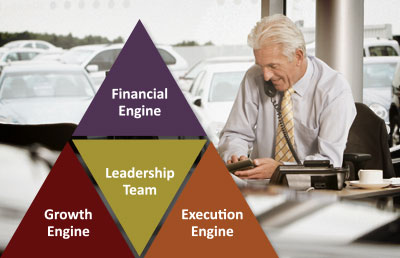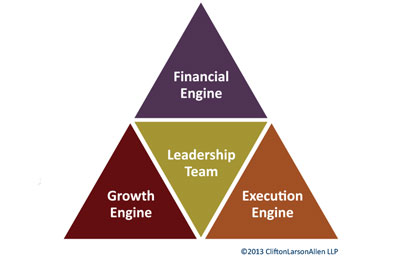
Two areas that can dramatically impact valuation are new vehicle franchise concentrations with a specific manufacturer, and the unique value proposition of a dealership brand in a market.
A risk that every dealer faces is locking up the majority of their personal net worth into the value of the dealership. Protecting the value of the dealership becomes critical to protecting the financial future of the dealer principal and the employees, families, and communities that depend on the success of the business.
It is often assumed that managing financial performance is the key to building a more valuable dealership. Clearly, financial performance is critical in any dealership and is a primary driver of business valuation. But financial results are a lagging indicator that tells you what has already happened. To increase value, the focus needs to shift to activities that are predictive of future performance — market conditions (growth), business processes (execution), and most importantly, leadership.
 A simple visual model called The Value Triangle illustrates the competencies required to achieve long-term success and increase dealership value. Excellence in any of these areas can create bursts of short-term success. However, consistent attention to all four areas of The Value Triangle creates high performance dealerships that can thrive in an extremely competitive automotive retail marketplace.
A simple visual model called The Value Triangle illustrates the competencies required to achieve long-term success and increase dealership value. Excellence in any of these areas can create bursts of short-term success. However, consistent attention to all four areas of The Value Triangle creates high performance dealerships that can thrive in an extremely competitive automotive retail marketplace.
Financial
Conventional wisdom tells us that the financial performance of a dealership depends on a balance of management practices and marketplace dynamics. But the strongest dealerships utilize disciplined management practices (those issues within their control) as the driving force to sustained levels of profitability. These dealers see operating profitably as a choice. Underperforming dealerships tend to credit or blame changes in the marketplace or manufacturer requirements (that are out of their control) as the most significant force impacting profits.
Our experience in the dealership industry has shown us that profitability and financial performance are mostly choices made by leadership and management. When it comes to financial performance, the ability to consistently generate positive cash flow under varying market conditions becomes a primary focus of any buyer. Profitability and consistent cash flow fuel the investments needed to sustain long-term growth and high levels of dealership performance. On the flip side, inconsistent profitability or weak cash flow significantly increases business risk and makes a dealership more vulnerable to market forces and the influence of the manufacturers.
Growth
Growth and profitability for many dealerships have rebounded to pre-recession levels. This is welcome news and confirms that growth opportunities do exist, especially for strong, disciplined performers.
Two areas that can dramatically impact valuation are new vehicle franchise concentrations with a specific manufacturer, and the unique value proposition of a dealership brand in a market. Those with revenues concentrated with a specific manufacturer will rise and fall to some extent with the new vehicles being developed by the manufacturer.
How effectively dealers manage and mitigate franchise concentrations is critical to the survival of the business, especially during periods of economic volatility. While the recent economic downturn was traumatic, it also forced many dealers who were captive to a single manufacturer to look for organic growth prospects within the dealership or with other franchises. The key areas that dealers are using to successfully mitigate franchise concentration risks include a greater focus on used vehicle sales and finance and insurance processes.
In order to remain relevant, dealerships must understand the unique value proposition of their brand within a market and how it aligns with their customers. Differentiators like a superior customer experience, efficient sales and service processes, and competitive pricing are key characteristics that distinguish successful dealers from their competitors. The ability to differentiate a dealership’s brand can create growth opportunities in any economy.
Execution
The best dealers continually execute within every department in their store. Execution is not just the ability to deliver or service a vehicle in a timely manner. It includes the ability to implement strategic plans, develop a strong bench of talented deparment managers, complete acquisitions and integrations of new dealerships, and continually drive operational improvements.
Dealerships that are strong in execution have a robust operating system that makes daily performance and continuous improvement the norm and not an exception. Those with strong execution also maintain high levels of financial working capital, building a strong foundational platform for the future. Strength in this area tends to make dealerships more profitable and require less outside capital to operate. This has a very positive impact on valuation.
Leadership
Leaders are responsible for connecting the financial, growth, and execution functions into a cohesive, high-functioning team. But leadership teams are not static. They evolve over time as people join and leave. Strong dealerships actively manage and plan for the ebb and flow of the leadership team.
Many in the Baby Boom generation are reaching an age where they are planning for the next phase of their lives. Since most dealerships are owned by Boomers, there are many dealers that are currently contemplating their succession or transition.
One of the riskiest periods for a dealership occurs during leadership or ownership transitions. With the right planning and approach, this can also be a period of revitalization and new ideas. It takes time to prepare for a transition that maximizes value for the current owners and ensures sustainability for the new owners. The best dealers start the succession planning process many years ahead of an expected transition.
A dealership driven by a high functioning management team has enterprise value. A dealership driven primarily by a single entrepreneur has individual value that evaporates when that person leaves, creating a disappointing valuation at the time of sale.
Forward focus on value creation
The innovation and resiliency demonstrated by dealership owners and industry leaders is truly amazing. While the Great Recession recast the competitive landscape for many industries, dealerships that have paid attention to the underlying fundamentals of The Value Triangle have met the challenge and continue to move forward and expand the value of their dealership. The opportunity to drive improved performance and enhance business value is significant as the dealership industry continues to expand.
